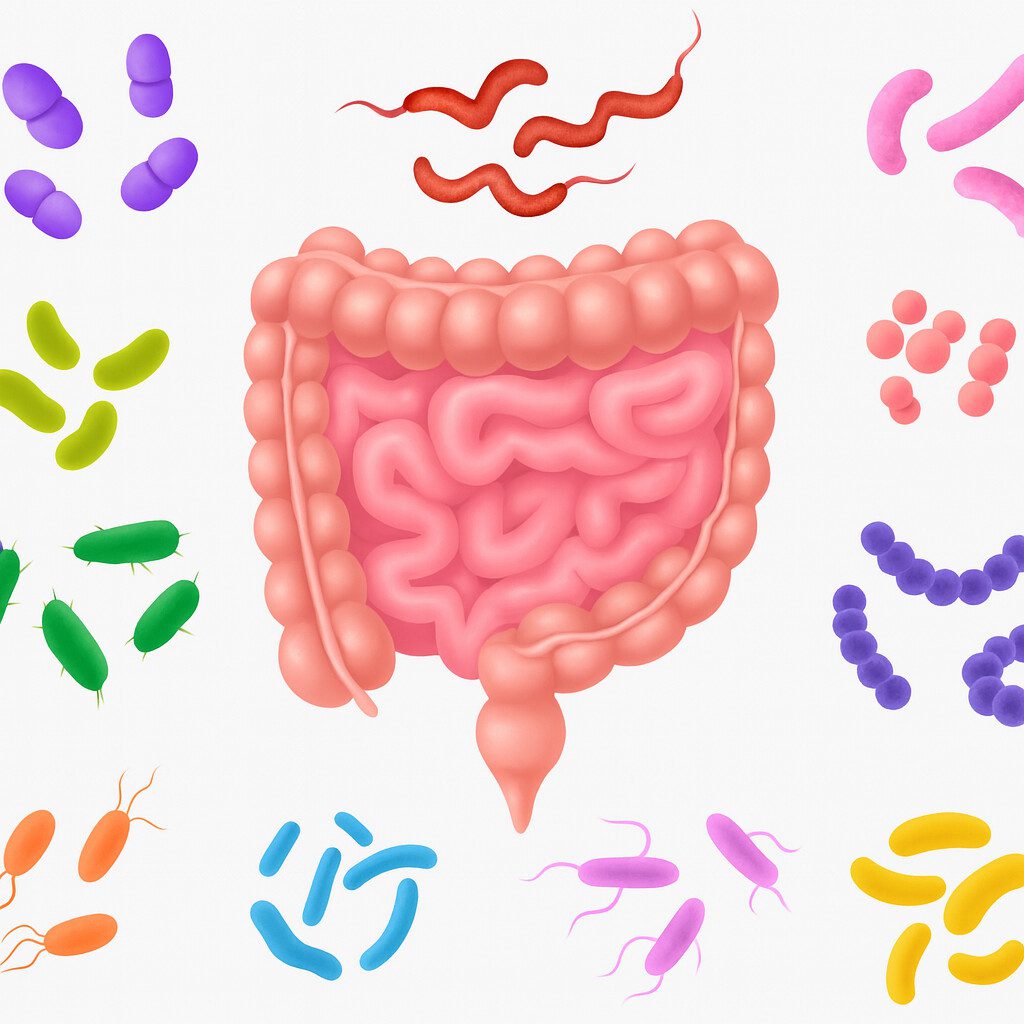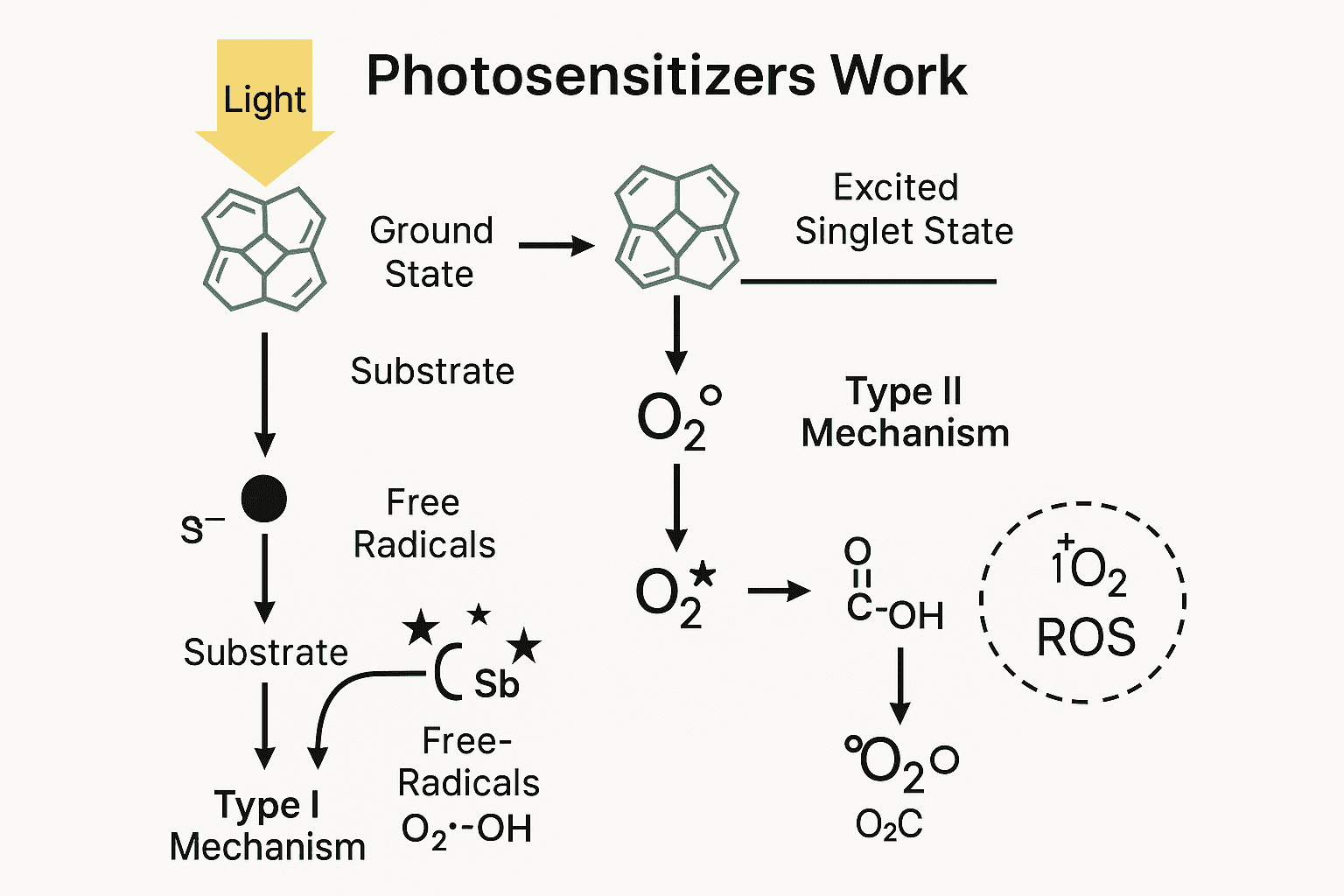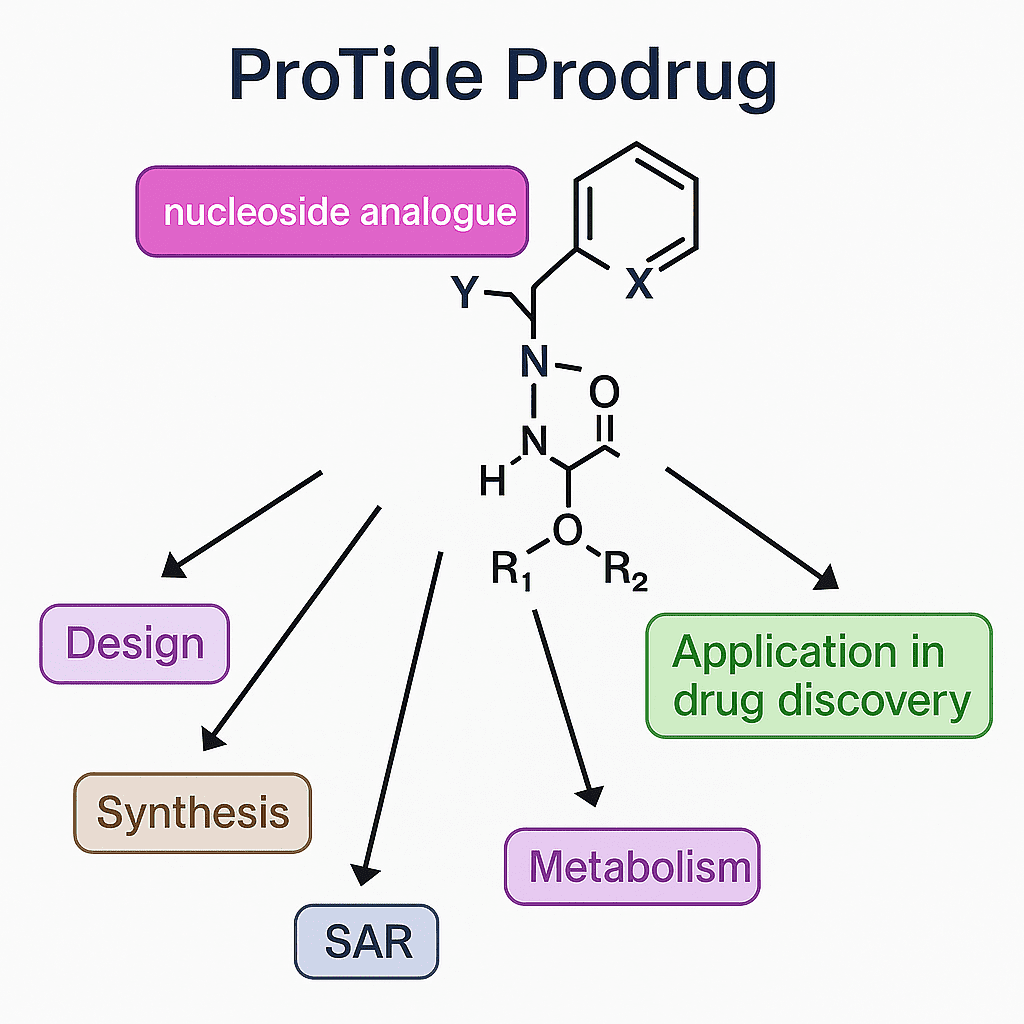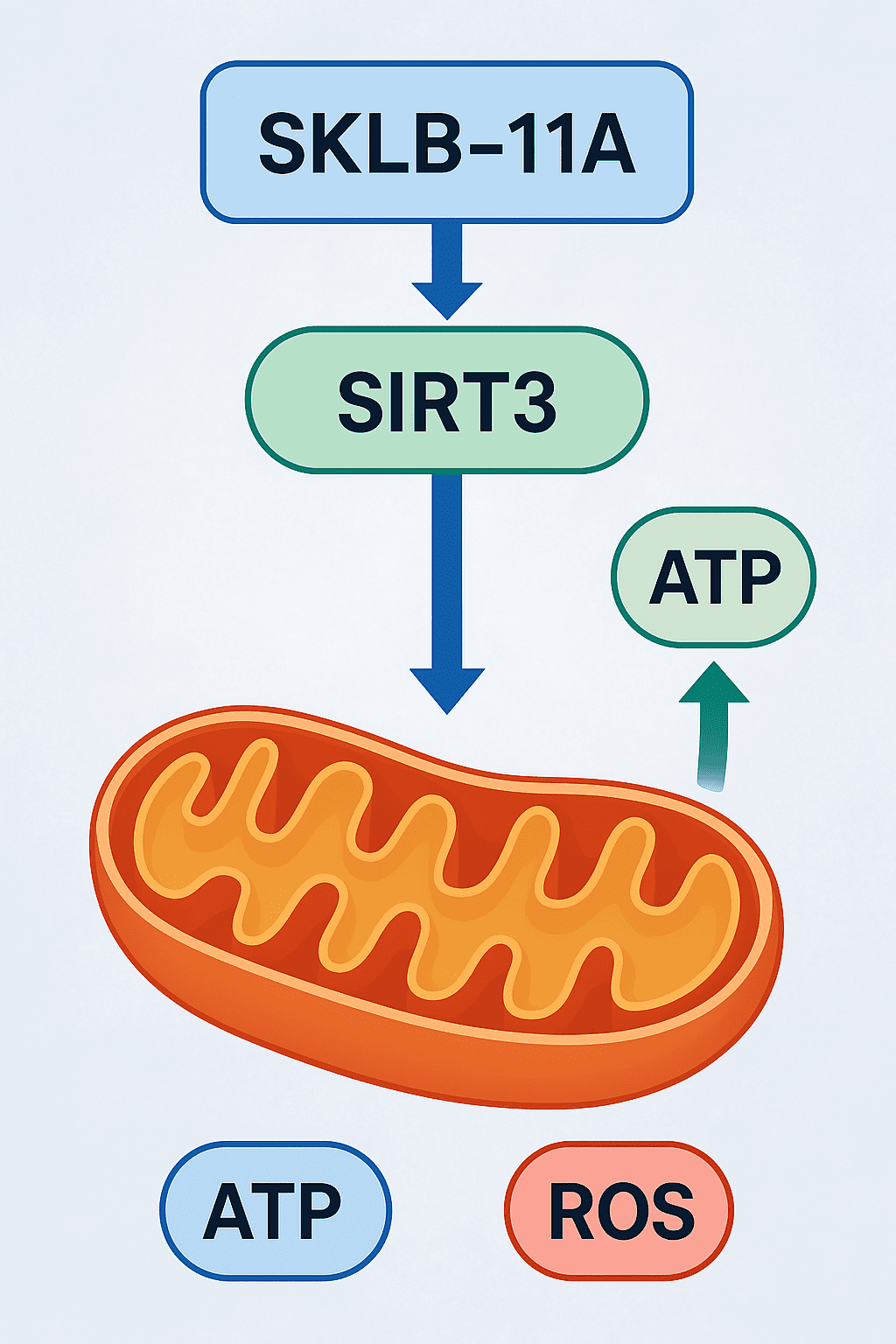The Future of Food Preservation: Why Nisin is Leading the Way
Abstract
Nisin is a natural antimicrobial peptide widely recognized for its role in food preservation. Produced by Lactococcus lactis, Nisin effectively inhibits Gram-positive bacteria, making it ideal for extending the shelf life of dairy, meat, canned, and beverage products. Approved by global regulatory bodies such as the FDA and EFSA, Nisin is considered safe, biodegradable, and suitable for clean-label formulations. With advancements in bioengineering, encapsulation, and synthetic biology, its potential extends beyond food into pharmaceuticals and healthcare. This blog explores the definition, benefits, real-world applications, safety profile, and future innovations of Nisin, highlighting why it is becoming an essential ingredient in modern food systems and beyond.
Introduction: Why Natural Preservatives Matter
In today’s health-conscious world, consumers are increasingly seeking transparency in the foods they consume. With rising awareness about the health risks associated with synthetic additives, the demand for clean-label and naturally preserved foods has surged. Modern shoppers are not just checking nutritional labels—they’re scanning for recognizable, natural ingredients that ensure both safety and freshness.
Preservatives are essential in maintaining the shelf life and safety of food products. They help prevent microbial spoilage, reduce food waste, and ensure products remain safe during transportation and storage. However, many traditional chemical preservatives like sodium benzoate or potassium sorbate are facing scrutiny due to potential health concerns and synthetic origins. This shift in perception has encouraged food manufacturers to explore more natural, sustainable alternatives.
Enter Nisin—a natural antimicrobial peptide produced by Lactococcus lactis. Recognized for its powerful ability to combat foodborne pathogens and extend shelf life without altering food flavor or texture, Nisin has become a frontrunner in the realm of natural food preservation. Its acceptance across global regulatory bodies like the FDA and EFSA further enhances its credibility and utility.
For food manufacturers, Nisin presents a strategic opportunity to meet consumer expectations while maintaining product safety. As natural preservation becomes a cornerstone of the clean-label movement, ingredients like Nisin are poised to play a central role in the future of food.
What is Nisin? A Natural Antimicrobial Wonder
Nisin is a naturally occurring antimicrobial peptide—also known as a bacteriocin—produced by the bacterium Lactococcus lactis, a strain commonly found in dairy environments. Discovered in the 1920s and commercially utilized since the 1950s, Nisin is one of the most researched and widely used natural preservatives in the food industry.
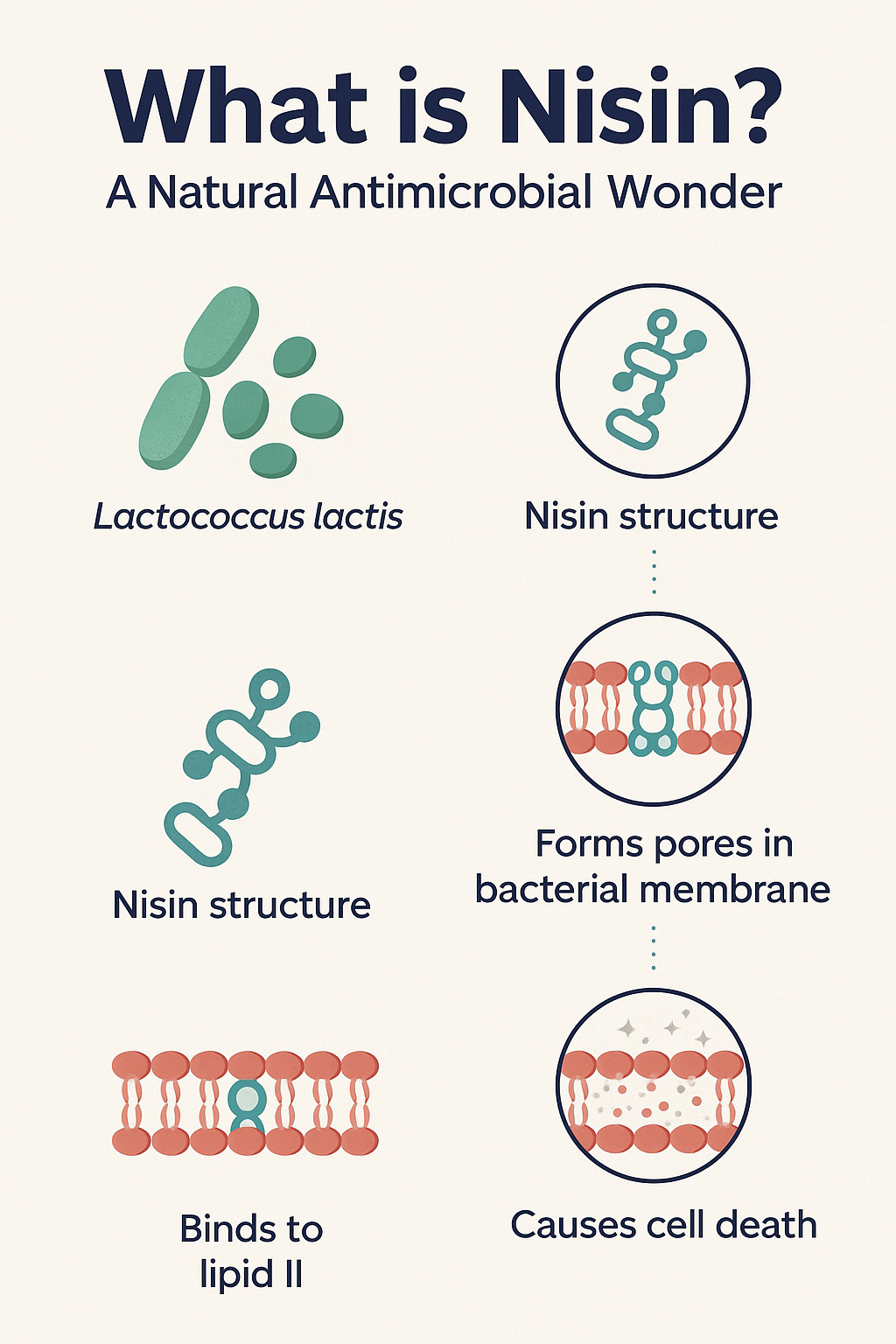
Belonging to the class of lantibiotics, Nisin contains unique amino acids like lanthionine, which give it its potent antimicrobial properties. Its primary mechanism of action involves binding to lipid II, a critical component in bacterial cell wall synthesis. Once bound, Nisin forms pores in the bacterial membrane, leading to leakage of cellular contents and eventual cell death. This mode of action makes Nisin particularly effective against a range of Gram-positive bacteria, including spoilage organisms and dangerous pathogens such as Listeria monocytogenes, Clostridium botulinum, and Staphylococcus aureus.
Importantly, Nisin is inactive against most Gram-negative bacteria, yeasts, and molds unless combined with permeabilizing agents. However, its efficacy, safety profile, and heat stability make it an ideal choice for pasteurized and processed foods.
Globally recognized as safe by agencies like the U.S. Food and Drug Administration (FDA) and the European Food Safety Authority (EFSA), Nisin is used in more than 50 countries under the food additive code E234. It is typically labeled as “Nisin (preservative)” or “natural preservative” on ingredient lists.
As clean-label and natural food products continue to trend upward, understanding what Nisin is and how it works is essential for both food manufacturers and informed consumers.
Top Benefits of Nisin for Food Preservation
Nisin stands out among natural preservatives for its broad-spectrum antimicrobial activity, safety, and versatility across food categories. As consumer preferences shift toward fewer synthetic additives, the benefits of Nisin become even more relevant for both food manufacturers and health-conscious buyers.
Where is Nisin Used? Real-Life Food & Beverage Applications
Nisin has found widespread acceptance across the global food and beverage industry thanks to its natural origin, safety profile, and efficiency in extending shelf life without compromising quality. From dairy to canned foods, its versatility is unmatched among natural preservatives.

1. Dairy Products
Nisin is extensively used in the preservation of cheeses, yogurts, and cream-based products. It controls spoilage bacteria and prevents the outgrowth of Clostridium and Lactobacillus species that can cause defects like gas formation and off-flavors. Its heat stability makes it ideal for pasteurized and processed cheese products.
2. Processed Meats
In products such as sausages, cured meats, and cold cuts, Nisin plays a critical role in inhibiting Listeria monocytogenes, a pathogen of major concern in ready-to-eat meats. Its application helps extend shelf life while reducing reliance on synthetic nitrites and other chemical additives.
3. Canned and Packaged Foods
Nisin is used in canned vegetables, soups, sauces, and ready-to-eat meals, where it helps suppress spore-forming bacteria like Bacillus and Clostridium species. Its ability to remain effective at a range of pH levels and processing temperatures makes it suitable for thermal treatments.
4. Beverages and Fermented Products
Some fruit juices, alcoholic drinks, and fermented beverages use Nisin to suppress unwanted microbial activity while preserving natural flavors. It is often integrated into clean-label beverage formulations.
Globally, Nisin is regulated under E234 in the EU, recognized as GRAS by the FDA, and approved in countries like Japan, China, Australia, and Brazil. Its labeling as a “natural preservative” aligns well with consumer trends toward transparency and minimal processing.
Is Nisin Safe? Regulatory Status and Scientific Backing
One of the most compelling reasons for Nisin’s growing popularity in the food industry is its proven safety profile, backed by decades of research and global regulatory acceptance. Derived from Lactococcus lactis, a naturally occurring bacterium used in traditional dairy fermentation, Nisin is a biodegradable, non-toxic preservative with an excellent safety record.
Numerous toxicological studies have confirmed that Nisin is not harmful to humans even when consumed at levels significantly higher than those used in food preservation. It is digested like any other protein in the gastrointestinal tract and does not accumulate in the body or affect gut microbiota when used in normal concentrations.
Nisin’s safety is recognized internationally:
In the United States, the Food and Drug Administration (FDA) classifies Nisin as Generally Recognized As Safe (GRAS) for specific food applications.
In the European Union, it is approved under the food additive code E234, and its use is tightly regulated to ensure safe intake levels.
The World Health Organization (WHO) and FAO Joint Expert Committee on Food Additives (JECFA) has also reviewed and validated its safety, establishing an Acceptable Daily Intake (ADI) of up to 33 mg per kg of body weight.
Nisin’s safety has also paved the way for its inclusion in organic and clean-label food products. Its natural origin and minimal impact on taste and nutrition make it an ideal solution for companies looking to replace synthetic preservatives without compromising product integrity.
Future of Nisin: Innovation & Market Potential
As consumer demand grows for sustainable, natural, and functional ingredients, Nisin is at the forefront of a new wave of food and biotech innovation. With its established antimicrobial efficacy and regulatory approval, researchers and industry experts are now exploring ways to enhance its functionality, expand its applications, and integrate it into next-generation food systems.
1. Bioengineering & Synthetic Biology
Scientists are bioengineering new Nisin variants (e.g., Nisin Z, Nisin Q, and hybrid peptides) with improved properties like broader antimicrobial spectrum, enhanced solubility, and resistance to proteolytic degradation. Advances in synthetic biology and precision fermentation are making it possible to tailor these molecules for specific pathogens or food matrices.
2. Innovative Delivery Systems
Encapsulation technologies such as liposomes, nanoparticles, and edible films are being developed to improve Nisin’s stability and control its release in complex food systems. These systems protect Nisin from degradation and allow targeted delivery, especially in multi-phase or extended-shelf-life products.
3. Applications Beyond Food
Recent research is exploring Nisin’s use in pharmaceuticals, oral care, wound healing, and veterinary medicine due to its anti-inflammatory, biofilm-disrupting, and antimicrobial capabilities. There is growing interest in using Nisin against antibiotic-resistant bacteria, including MRSA.
4. Market Trends & Industry Growth
The global market for natural antimicrobials is projected to grow significantly, driven by consumer awareness and regulatory shifts. Nisin is poised to become a cornerstone of clean-label, plant-based, and functional food trends. Major food and ingredient companies are actively investing in Nisin-based technologies, indicating robust future growth.
With innovation spanning bioengineering, delivery systems, and therapeutic potential, Nisin’s journey is just beginning.
1. Effective Against Dangerous Pathogens
Nisin is especially potent against a range of Gram-positive bacteria, including foodborne pathogens like Listeria monocytogenes, Clostridium botulinum, and Bacillus cereus. These microbes are responsible for some of the most serious food safety issues. By targeting their cell walls, Nisin effectively inhibits their growth and prolongs the safety window of perishable foods.
2. Enhances Shelf Life Naturally
Unlike synthetic preservatives, Nisin offers an eco-friendly, biodegradable option to extend the shelf life of processed, refrigerated, and canned products. Its stability under various temperature and pH conditions makes it suitable for pasteurized, fermented, and acidic foods.
3. Maintains Sensory Quality
One of Nisin’s key advantages is that it does not alter the taste, aroma, or appearance of the food. This makes it ideal for high-quality consumer products where maintaining natural flavor profiles is crucial.
4. Recognized Safety and Regulatory Approval
Approved as a food additive in over 50 countries, including under the FDA’s GRAS (Generally Recognized As Safe) status and the EU’s E-number E234, Nisin meets global food safety standards. It is also accepted in organic and clean-label formulations in many regions.
As sustainability, food safety, and consumer trust become cornerstones of food innovation, Nisin offers a compelling, science-backed solution for modern preservation challenges.
References
Delves-Broughton, J., Blackburn, P., Evans, R. J., & Hugenholtz, J. (1996). Applications of the bacteriocin, nisin. Antonie van Leeuwenhoek, 69(2), 193–202. https://doi.org/10.1007/BF00399424
https://link.springer.com/article/10.1007/BF00399424
Cutter, C. N. (2000). Antimicrobial effect of herb extracts against Escherichia coli O157:H7, Listeria monocytogenes, and Salmonella typhimurium associated with beef. Journal of Food Protection, 63(5), 601–607. https://doi.org/10.4315/0362-028X-63.5.601
https://www.sciencedirect.com/science/article/pii/S0362028X22001004
Gálvez, A., Abriouel, H., López, R. L., & Omar, N. B. (2007). Bacteriocin-based strategies for food biopreservation. International Journal of Food Microbiology, 120(1–2), 51–70. https://doi.org/10.1016/j.ijfoodmicro.2007.06.001
https://www.sciencedirect.com/science/article/abs/pii/S0168160507003066
Cleveland, J., Montville, T. J., Nes, I. F., & Chikindas, M. L. (2001). Bacteriocins: Safe, natural antimicrobials for food preservation. International Journal of Food Microbiology, 71(1), 1–20.
https://www.sciencedirect.com/science/article/abs/pii/S0168160501005608
Gharsallaoui, A., Oulahal, N., Joly, C., & Degraeve, P. (2016). Nisin as a food preservative: Part 1. Physicochemical properties, antimicrobial activity, and main uses. Critical Reviews in Food Science and Nutrition, 56(8), 1262–1274. https://doi.org/10.1080/10408398.2013.763766
https://www.tandfonline.com/doi/abs/10.1080/10408398.2013.763766
Wiedemann, I., Breukink, E., van Kraaij, C., Kuipers, O. P., Bierbaum, G., de Kruijff, B., & Sahl, H. G. (2001). Specific binding of nisin to the peptidoglycan precursor lipid II combines pore formation and inhibition of cell wall biosynthesis for potent antibiotic activity. The Journal of Biological Chemistry, 276(1), 1772–1779. https://doi.org/10.1074/jbc.M006770200
https://www.jbc.org/article/S0021-9258(18)46673-2/fulltext
Deegan, L. H., Cotter, P. D., Hill, C., & Ross, P. (2006). Bacteriocins: Biological tools for bio-preservation and shelf-life extension. International Dairy Journal, 16(9), 1058–1071.
https://www.sciencedirect.com/science/article/abs/pii/S0958694605002827
Field, D., Cotter, P. D., Hill, C., & Ross, R. P. (2015). Bioengineering nisin to improve its antimicrobial properties for food and pharmaceutical applications. Frontiers in Microbiology, 6, 358. https://doi.org/10.3389/fmicb.2015.00358
https://www.frontiersin.org/journals/microbiology/articles/10.3389/fmicb.2015.00358/full
Abee, T., Krockel, L., & Hill, C. (1995). Bacteriocins: Modes of action and potentials in food preservation and control of food poisoning. International Journal of Food Microbiology, 28(2), 169–185.
https://www.sciencedirect.com/science/article/abs/pii/0168160595000550

